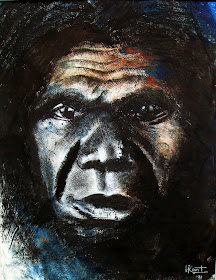 |
| Fukushima Ghosts III, oil on paper, 58x46 cm |
My experimentation continues at creating evocative and expressive images of people under extreme stress with this piece, the third of my Fukushima ghosts (see the previous two here) . My aims are to explore expressive mark-making in portrait painting, to make social comment on a current world event, and to create eloquent images about the human condition.
For this painting i switched to a black absorbent paper that soaked up the oil paint and medium. I flooded the paper with both. The pigment moved about through gravity as i rotated the paper at strategic moments. I was allowing the paint its agency. I was relying on its agency. It was a partnership. We, the paint and i, are co-responsible for the way the work turned out.
Abstract figurative painting developed as American Abstract Expressionism was running out of steam in the 1950's. Many had declared the death of figurative painting some years earlier, and saw Abstract Figurative painting as a contradiction in terms. These theorists maintained that abstraction and figuration were at opposite ends of a continuum and so it made no sense to mix them.
But in hindsight such assertions were silly and pointless. As Kandinsky says, "There is no must in art, for art is free." This was quite the sentiment of the new journal Reality, founded in 1953, when the founding committee stated that the Journal's intention was “to rise to the defense of any painter’s right to paint any ways he wants.”
But all that abstraction and expressionism does the raise the question, "What ever happened to portraiture being the painting of a likeness to someone?". How can a puddle of paint be called a 'likeness'? It may, at a stretch, be called figurative, but surely not portraiture.
I have touched on this issue in a previous post when considering the legitimacy of using photography as a basis for portrait painting. Let me just add now that notions of what might be a portrait have considerably expanded over the previous century.
William Dobell's 1943 Archibald Prize win was controversial, as some people argued that his portrait of Joshua Smith so distorted Smith's features that it could not be called a portrait. The issue went to court, the case hinging on the accepted definition of portraiture: how faithfully did a portrait have to represent the sitter? Dobell's vindication expanded the concept of what could be a portrait, and abstract interpretations as well as conventional portraits were subsequently admitted to the Archibald.
The Post-Sigmund Freud years have seen more interest in the personality, the neuroses even, of the subject, and less insistence on accurate draughtsmanship in the production of a photographic physical likeness. With the rise of Expressionism we have come to value discovering the personality of the artist in his or her work. We prize Egon Schiele's drawings for those very reasons.
Francis Bacon painted a portrait of Lucian Freud not from a sitting by LF, not even from a photo of LF, but from a photo of Kafka as his inspiration (Kafa was LF's fav author at the time). Bacon's self-portraits contain some talisman of himself (a bag under an eye, or the sweep of hair across the forehead) but these iconic indicators hardly constitute a likeness in the conventional sense. Yet we accept that Bacon painted a portrait of Lucian Freud and numerous self-portraits.
A spokesperson from the British National Portrait Gallery put the view in an on-line portrait painting forum that “all of the body is a portrait. I've seen fabulous portraits, full of character, showing only a hand, personified in such a way that the entire character of the person was contained. Such work is rare, but possible.”
So a mere personification may be considered a portrait. Paintings containing symbolic objects alluding to the identity of the sitter may be considered portraits. A DNA printout, suitably framed and hung in the National Portrait Gallery, would be considered a portrait.
Maybe Fukushima Ghosts III is not a portrait. It is not of any known individual. Even if it were, the face is contained within the mask of a Hazmat suit. And the painterly treatment of the suit is so fluid that it is hardly even recognizable as a protective item of clothing.
Furthermore, the painting purports to be that of a ghost. And ghosts don't exist. So all-in-all, it can't be a portrait. It can't really even be called a figurative painting. Maybe a fantasy painting? Surreal?
Yet i don't think so. I think it is a portrait. It is a generic portrait representing many anonymous individuals currently alive and working hard in Japan. Indeed, the anonymity of the workers has been one the key themes running through my Fukushima series, for it is a socially telling marker. Their anonymity is revealing!
These generic portraits of anonymous workers are like the statues at the Tomb of the Unknown Soldier. The identity of the statue does not have to be known but the sense of humanity, of service and of suffering behind the work is palpable come Remembrance Day ceremonials.
Actually, we don't recognize the persons in the vast majority of portraits we come across in our lives! And i'm talking Rembrandt and Singer Sargent.
That leaves us unable to say anything about the quality of the likeness. Yet we prize the portraits of these artists. We prize them for the painterly skill in their execution and we prize them for the humanity they reveal about an unknown sitter, about an artist long dead, about a time and society otherwise obscured in history.
















